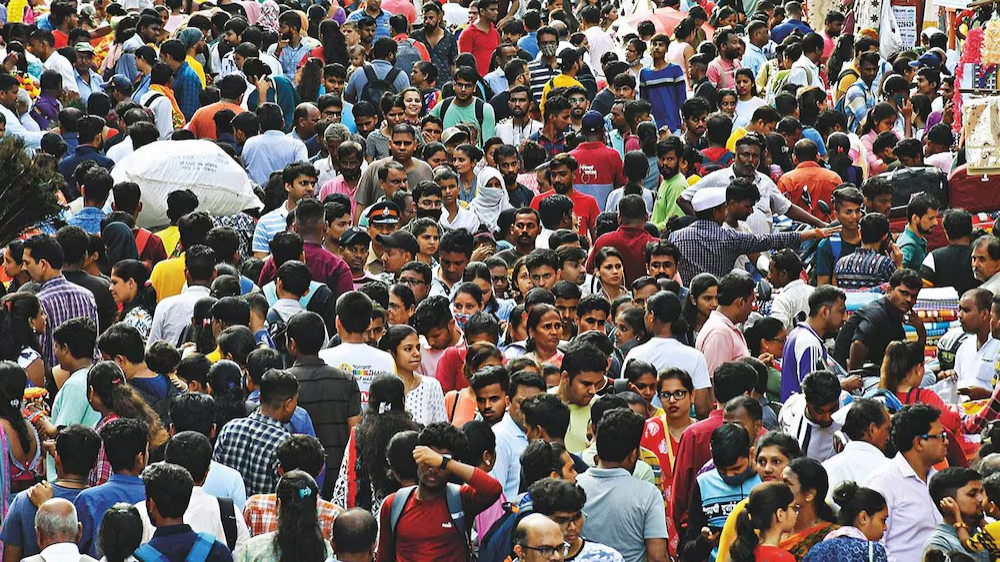India, with a population surpassing 1.4 billion, is undergoing notable demographic changes. These shifts have far-reaching implications for the nation’s economy, society, and environment. As India faces a slowing population growth rate, declining fertility, and rising life expectancy, it encounters both opportunities and challenges in shaping its future. The country’s ability to harness its growing youth population while addressing critical issues like healthcare, education, and employment will determine its long-term prosperity and sustainability in the years ahead.
Population

Mohan Bhagwat proposes a three-child policy in response to India’s declining fertility rate. The proposal has sparked discussions about the potential economic and social impacts of India’s changing demographics. Critics raise concerns about whether such population control measures are the most effective approach, while some advocate for sustainable growth and addressing underlying issues in the economy.
History of Population Growth in India
Slow Growth (1891-1921): Population growth was minimal due to famines, plagues, and epidemics, leading to significant losses.
High Growth (1921-1951): Post-1921, India saw rapid population growth, marking the “Great Divide” in demographic history.
Population Explosion (1951-1981): A sharp population increase during this period, often called the “population explosion.”
Slowing Growth (1981 onwards): Starting in the 1980s, growth rates slowed, showing signs of stabilizing.
Recent Trends: Fertility rates dropped below replacement level, and India’s population is projected to peak at 1.67 billion by 2050.
Future Projections: India’s population is expected to stabilize around 1.53 billion by 2100, according to UN estimates.
Population Growth and Fertility Trends
- India’s Total Fertility Rate (TFR) has decreased to 2.1 children per woman in recent years, which is at the replacement level for population sustainability.
- Fertility rates in states like Kerala, Tamil Nadu, and West Bengal have already dropped below replacement levels, while other states like Uttar Pradesh and Bihar continue to have higher fertility rates.
- The population of India is expected to peak at 1.7 billion around 2050, after which it is anticipated to gradually stabilize or decline due to lower fertility rates and an aging population.
Birth and Death Rates
- India’s Total Fertility Rate (TFR) has decreased to 2.0 children per woman in recent years, which is at the replacement level for population sustainability.
- Fertility rates in states like Kerala, Tamil Nadu, and West Bengal have already dropped below replacement levels, while other states like Uttar Pradesh and Bihar continue to have higher fertility rates.
- The population of India is expected to peak at 1.7 billion around 2050, after which it is anticipated to gradually stabilize or decline due to lower fertility rates and an aging population.
Demographic Transition and the 'Demographic Dividend'
- India is in the third stage of demographic transition, where birth rates are falling significantly, resulting in a larger working-age population.
- Currently, about 65% of India’s population is under the age of 35, providing a potential demographic dividend.
- If India can tap into this youthful workforce and bridge skill gaps, it could see rapid economic growth.
- However, challenges like unemployment, underemployment, and lack of quality education need to be addressed to fully capitalize on this demographic advantage.
Challenges of a Growing Population
- Urbanization: Rapid growth of cities is leading to overcrowded urban areas, putting a strain on infrastructure, housing, and public services.
- Resource management: Increased demand for water, food, and energy is testing the country’s natural resources.
- Regional disparities: States like Uttar Pradesh and Bihar continue to have high fertility rates, contributing to regional imbalances in population distribution and development.
Policies and Future Projections
- The Indian government has implemented various family planning policies and awareness campaigns to help manage population growth, reduce fertility rates, and improve maternal and child health.
- As fertility rates decline, India’s population is projected to reach 1.7 billion by 2050, which will require substantial investments in healthcare, education, infrastructure, and job creation to sustain economic growth and improve the quality of life for its citizens.
Conclusion
India’s population dynamics present both opportunities and challenges. By focusing on enhancing education, healthcare, and employment, India can leverage its demographic trends to fuel economic growth and improve quality of life. As the country moves forward, managing population growth will be crucial to ensuring sustainable development and achieving long-term prosperity. The next decades will determine whether India can effectively capitalize on its growing young population and changing demographics.
Practice Essay:
“India’s Population Dynamics, Challenges, and Opportunities for the Future“
0
0
votes
Article Rating
Subscribe
Login
0 Comments
Oldest
Newest
Most Voted
Inline Feedbacks
View all comments